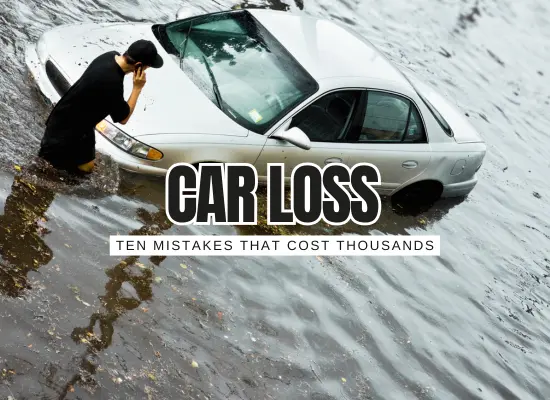Floods total cars fast, but paperwork and small missteps total claims even faster. Use this playbook to avoid the top mistakes that lead to denials, lowball payouts, or salvage titles you did not expect. You will see exactly what to do, when to do it, and how to document a clean claim.
The 10 Mistakes That Kill Claims
1) Starting the engine
Cranking a waterlogged engine can cause hydrolock and secondary damage that adjusters may view as avoidable. Leave the key out. Disconnect battery only if safe.
2) Moving the car without proof
Always mark and photograph the high water line on doors, seats, firewall, and trunk before towing. Include odometer, VIN plate, and plate number in photos.
3) Ripping out seats and carpet too early
Do not remove parts before the adjuster documents damage unless your policy or adjuster authorizes it in writing. Keep all removed items for inspection.
4) Skipping a saltwater note
Saltwater and brackish exposure accelerates corrosion and electronics failure. Record where the car flooded and whether it was coastal surge or rainfall.
5) Not calling your insurer first
Open the claim early and request an insurer approved tow and storage site. Unauthorized storage fees can eat into settlement.
6) Accepting a low ACV without comps
Ask for the valuation report. Pull comparable vehicles with similar trim, mileage, packages, and local market pricing. Provide maintenance and upgrade receipts.
7) Ignoring title and lien issues
If the car is totaled you will sign the title to the insurer. Lenders are paid first. Know whether the settlement clears the loan or if you need GAP insurance.
8) Driving a partial-flood car without diagnostics
Water wicks into harnesses and modules. Demand a scan report. Even shallow water can compromise seat airbags, pretensioners, and hybrid batteries.
9) Letting mold and corrosion set in
If authorized for repair, dehumidify fast. Pull sill trim to vent cavities. HEPA vacuum silt. Keep a moisture log to show mitigation efforts.
10) Poor documentation and timelines
Missing receipts and unclear timelines slow payouts. Keep a folder with photos, tow slips, storage invoices, and every call note with date and time.
Water Type Matters
| Type | Typical damage pattern | Claim effect |
|---|---|---|
| Rainwater | Less corrosive, but mud and silt can ruin bearings, carpets, modules | Repair more likely if electronics survived |
| Brackish | Salt plus silt causes fast corrosion and delayed electrical failures | Often pushes toward total loss |
| Saltwater surge | Severe corrosion, wiring and module damage, HVAC contamination | Total loss is common |
Write the water type on your claim. If unknown, state where the vehicle was when flooded.
First 24 Hours: Do and Do Not
| Do | Do not |
|---|---|
| Photograph the car inside and out, including water line and interior water level | Do not start the engine, even to move the car a few feet |
| Call insurer, request claim number, approved tow, and dry storage | Do not authorize teardown without written approval |
| Remove personal items and place keys in a sealed bag | Do not discard soaked parts until after adjuster inspection |
| If safe, crack windows and run a dehumidifier near the car | Do not connect a charger to a submerged battery or hybrid pack |
Payout Math Mini Calculator
Estimate whether a claim leans toward total loss or repair and your likely out-of-pocket amount. This is a planning tool, not a claim guarantee.
Your Results
Direction is a rough signal. Saltwater increases the chance of total loss due to corrosion and electronics risk.
Documents That Win Claims
Open checklist
- Claim number, adjuster name, and contact info
- High water photos with date and location
- Odometer, VIN plate, license plate photos
- Scan report from shop if available
- Maintenance, upgrades, and tire receipts
- Tow, storage, and rental receipts
- Lienholder contact and loan payoff letter
Rental, Title, and Aftermath
- Rental coverage: If included, confirm daily limit and total days. Book early in disaster zones.
- Title branding: Flood totals usually result in a branded or salvage title. Ask the insurer how it will be coded in your state.
- Buyback option: Some owners can buy back the salvage. Understand fees, title status, and future insurability first.
- Sale disclosure: Future buyers must be told about flood damage where required by law.
Vehicle flood claims move faster when you avoid secondary damage, document the water line, and keep receipts in one place. Policies and state rules differ, so confirm coverage terms, title implications, and next steps with your insurer and repair shop before you authorize work.


